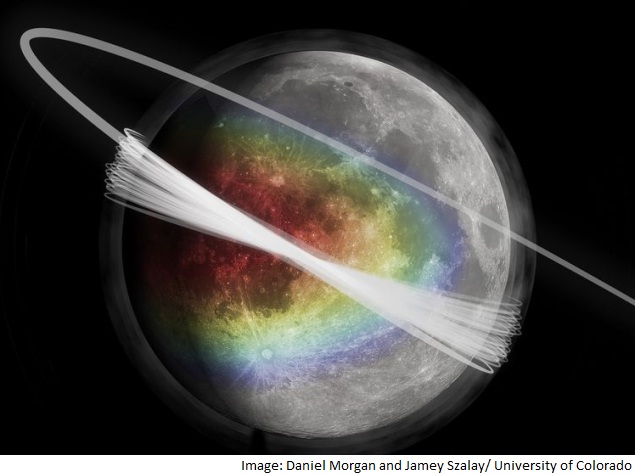- Home
- Science
- Science News
- The Moon Is Engulfed in a Permanent, Lopsided Dust Cloud: Study
The Moon Is Engulfed in a Permanent, Lopsided Dust Cloud: Study

Astronomers said the dust cloud increases in density when annual events like the Geminids meteor shower spew shooting stars.
The cloud is made up primarily of tiny dust grains kicked up from the Moon's surface by the impact of high-speed, interplanetary dust particles, said University of Colorado Boulder physics Professor Mihaly Horanyi.
A single dust particle from a comet striking the Moon's surface lofts thousands of smaller dust specks into the airless environment, and the lunar cloud is maintained by regular impacts from such particles, said Horanyi.
The cloud was discovered using data from Nasa's Lunar Atmosphere and Dust Environment Explorer, or LADEE, which launched in September 2013 and orbited the Moon for about six months.
A detector on board called the Lunar Dust Experiment (LDEX) designed and built by CU-Boulder charted more than 140,000 impacts during the six-month mission.
Horanyi said the first hints of a cloud of dust around the Moon came in the late 1960s when Nasa cameras aboard unmanned Moon landers captured a bright glow during lunar sunsets.
Several years later, Apollo astronauts orbiting the Moon reported a significant glow above the lunar surface when approaching sunrise, a phenomenon which was brighter than what the Sun alone should have been able to generate at that location.
Since the new findings don't square with the Apollo reports of a thicker, higher dust cloud, conditions back then may have been somewhat different, said Horanyi.
The dust on the Moon - which is dark and sticky and regularly dirtied the suits of moonwalking astronauts - was created over several billion years as interplanetary dust particles incessantly pounded the rocky lunar surface.
Knowledge of the dusty environments in space has practical applications, said Horanyi.
Knowing where the dust is and where it is headed in the solar system, for example, could help mitigate hazards for future human exploration, including dust particles damaging spacecraft or harming astronauts.
The Geminid meteor showers occur each December when Earth plows through a cloud of debris from an oddball object called Phaethon, which some astronomers describe as a cross between an asteroid and a comet.
"When these 'beams' we see from meteors at night hit the moon at the right time and place, we see the cloud density above the Moon skyrocket for a few days," said Horanyi.
The study was published in the journal Nature.
Catch the latest from the Consumer Electronics Show on Gadgets 360, at our CES 2026 hub.
Related Stories
- Samsung Galaxy Unpacked 2025
- ChatGPT
- Redmi Note 14 Pro+
- iPhone 16
- Apple Vision Pro
- Oneplus 12
- OnePlus Nord CE 3 Lite 5G
- iPhone 13
- Xiaomi 14 Pro
- Oppo Find N3
- Tecno Spark Go (2023)
- Realme V30
- Best Phones Under 25000
- Samsung Galaxy S24 Series
- Cryptocurrency
- iQoo 12
- Samsung Galaxy S24 Ultra
- Giottus
- Samsung Galaxy Z Flip 5
- Apple 'Scary Fast'
- Housefull 5
- GoPro Hero 12 Black Review
- Invincible Season 2
- JioGlass
- HD Ready TV
- Laptop Under 50000
- Smartwatch Under 10000
- Latest Mobile Phones
- Compare Phones
- OPPO Reno 15 Pro Max
- Honor Win RT
- Honor Win
- Xiaomi 17 Ultra Leica Edition
- Xiaomi 17 Ultra
- Huawei Nova 15
- Huawei Nova 15 Pro
- Huawei Nova 15 Ultra
- Asus ProArt P16
- MacBook Pro 14-inch (M5, 2025)
- OPPO Pad Air 5
- Huawei MatePad 11.5 (2026)
- Xiaomi Watch 5
- Huawei Watch 10th Anniversary Edition
- Acerpure Nitro Z Series 100-inch QLED TV
- Samsung 43 Inch LED Ultra HD (4K) Smart TV (UA43UE81AFULXL)
- Asus ROG Ally
- Nintendo Switch Lite
- Haier 1.6 Ton 5 Star Inverter Split AC (HSU19G-MZAID5BN-INV)
- Haier 1.6 Ton 5 Star Inverter Split AC (HSU19G-MZAIM5BN-INV)

















